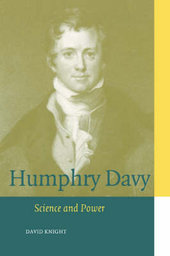
|
Humphry Davy: Science and Power
Paperback / softback
Main Details
| Title |
Humphry Davy: Science and Power
|
| Authors and Contributors |
By (author) David Knight
|
| Series | Cambridge Science Biographies |
|---|
| Physical Properties |
| Format:Paperback / softback | | Pages:236 | | Dimensions(mm): Height 227,Width 152 |
|
| Category/Genre | Popular science |
|---|
| ISBN/Barcode |
9780521565394
|
| Classifications | Dewey:509.2 |
|---|
| Audience | | General | | Professional & Vocational | | Tertiary Education (US: College) | |
|---|
| Illustrations |
Worked examples or Exercises
|
|
Publishing Details |
| Publisher |
Cambridge University Press
|
| Imprint |
Cambridge University Press
|
| Publication Date |
5 February 1998 |
| Publication Country |
United Kingdom
|
Description
In this illuminating and entertaining biography David Knight draws upon Humphry Davy's poetry, notebooks, and informal writings to introduce us to one of the first professional scientists. Davy is best remembered for his work on laughing gas, for the arc lamp, for isolating sodium and potassium, for his theory that chemical affinity is electrical, and, of course, for his safety lamp. His lectures on science made the fortunes of the Royal Institution in London, and he taught chemistry to the young Faraday. He is also recognized for his poetry and was the friend of Coleridge, Wordsworth, and Byron. By investigating Davy's life Knight shows what it was like to be a creative scientist in Regency Britain, demonstrating the development of science and its institutions during this crucial period in history.
Reviews'... absorbing and so beautifully written ... it is indeed rare to encounter a text that at one and the same time represents a major piece of scholarship and yet is notably accessible, illuminating and entertaining.' Dr B. Dixon, New Scientist 'I highly recommend this book. Knight has vividly depicted the life and times of the greatest creative scientist in Regency Britain along with the development of science and its institutions during this crucial historical period.' George B. Kauffman, Chemistry and Industry
|